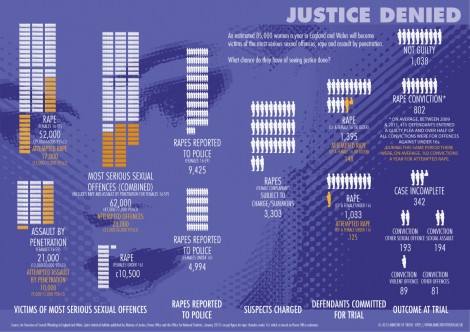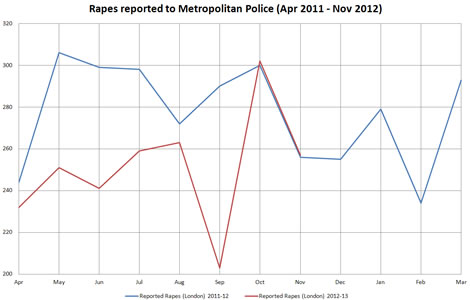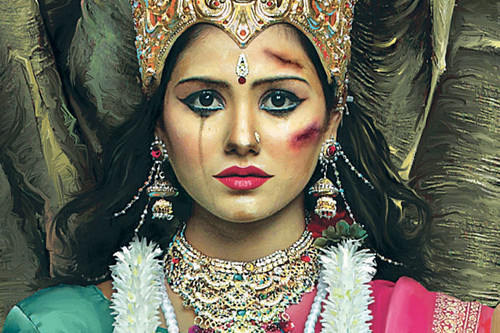Recent Feminism Articles
The Stuart Hall case ends the debate on anonymity for rape defendants
Having strenuously protested his innocence just three months ago, veteran BBC broadcaster Stuart Hall last week admitted he sexually abused girls – one of whom was as young as nine.
The Hall case shows more than ever just how vital it is that we continue to name men accused of rape and sexual assault. Because it is this naming that can give survivors and victims the confidence to come forward.
In Hall’s case, the police and CPS have been vocal in their argument for naming defendants. They have explained how naming Hall helped lead to his guilty admission. As survivors recognised that they were not alone, that he had attacked others, the police were able to gather the evidence they needed to charge and eventually prosecute.
We see the same pattern over and over again. Serial rapist John Worboys is a key example in how naming a defendant helped lead to his conviction. After he was named, it became impossible for the police to ignore the weight, the sheer amount, of women coming forward to name him as their rapist. Naming leads to evidence which helps lead to convictions.
Some argue that if we name the accused we should name the alleged victim. But why? Naming the victim isn’t going to help lead to convictions, it’s not going to help secure justice for rape survivors.
People cry ‘false accusations’ but if a woman is charged with that specific crime, then of course she will be named as she will be a defendant herself. The case of Ched Evans shows what can happen when you name the survivor. His victim was victimised all over again when she was subjected to horrific abuse to the point that she had to change her name and flee her home. How can we have ended up in a situation where some treat rapists with more sympathy and respect than their victims?
When criticising the policy of naming defendants, I think people confuse two different issues. The first is the legal issue and the indisputable, mounting, continuing evidence that naming helps convict rapists. The second is media behaviour.
The fact that the media convict people in their pages and often seem to tread a very narrow line between reporting and contempt of court is not a reason to end the policy of naming defendants. It is too important a policy, too important in bringing justice to victims and survivors, to be dropped because the press behave intrusively.
Press behaviour is an issue for the press. If they harass and taunt and wrongly convict men in their pages then that is not the fault of a sensible law that helps bring justice to rape victims. Bad behaviour in some sections of the media is not a reason to deny women and girls up and down the UK justice.
—
A longer version of this blog-post is here.
Convictions for rape: how the Crown Prosecution Service is misleading us
According to the Crown Prosecution Service, rape convictions have hit an all -time high:
The Crown Prosecution Service has today published new figures that show the conviction rate for rape and domestic violence prosecutions increased once again last year.
The statistics show that the conviction rate for rape prosecutions has continued to rise to the highest on record, from 58% in 2007/08 to 63% in 2012/13. CPS recorded data on rape prosecutions includes all cases initially charged and flagged as rape, including those cases where a conviction was obtained for alternative sexual offences or serious offences of homicide or offences against the person.
Ah, but have you noticed the caveat in paragraph 2?
In the parallel universe that bureaucrats inhabit a ‘rape conviction’ is not actually a conviction for rape, it includes any conviction is a case that was initially charged and flagged as a rape, even if the actual rape charge was dropped before the case reached court or the defendant was acquitted of rape but convicted on a lesser offence.
In short, however good the overall conviction rate in these case might now look on paper, the claim that rape convictions have hit an all-time high is bullshit, a point that I made back in March 2012 when they tried the same bullshit arguments.
I’ve pulled together this [hopefully] handy infographic which lays out the truth about rape – from the British Crime Survey estimates for annual prevalence of rape and other serious sexual offences, to the CPS’s own audited figures for outcomes (for cases initiated in 2009).
Starting from a annual baseline of 85,000 completed or attempted serious sexual offences against adult women in England and Wales, plus around 10,500 rapes in which the victim was a female child (i.e. under 16), the criminal justice system delivered just 802 actual rape convictions.
I.e. where a defendant was actually convicted of rape and not a lesser offence, of which over half (415) came by way of a guilty plea and just over half were for offences against children.
In short, in that audited data, less than 400 actual convictions for rape related to offences in which the female victim was aged 16 or over.

Full file here (large 6mb PDF).
Copyright notionally creative commons non-commercial licence, but I can also waive that if the poster’s being used for fund-raising purposes by a non-profit organisation.
A call to arms on International Women’s Day
I am not often filled with rage but earlier this week I attended a screening of ‘Banaz: a Love Story‘ directed by the Human Rights activist, Deeyah, and I felt such frustration and anger.
We hear statistics about the numbers of young people, mainly women, experiencing so-called ‘honour’ based violence and oppression but watching this young woman, who was eventually murdered by her family members, gave a stark insight into the horror of what these young people, mainly women, are enduring on a daily basis.
The figures for domestic violence in the UK are harsh, make no mistake. The Home Office reported that in the UK 1 in 4 women will suffer domestic violence in their lifetimes and the Home Office reported that in 2010/11, 21 men and 93 women were killed by a partner, ex-partner or lover in the UK.
The Forced Marriage Unit published its figures this week indicating that they gave advice or support related to a possible forced marriage in 1485 cases involving 60 different countries across Asia, the Middle East, Africa, Europe and North America last year. Of the 744 cases where the age was known, over 600 of those involved were young people under the age of 26.
What I saw on screen a young woman fighting for her life. She fought time and time again. Her father sought to break her will and her spirit. This is exactly what this hate crime – because it is a hate crime – seeks to achieve. There is an intense hatred and fear of women: their autonomy, their sexuality, their intellect, their very essence.
She was mutilated at a young age so she would derive no pleasure from sexual activity; as she grew older she was not allowed friends as they would be a negative influence on her; when she turned 17, her father and uncle arranged her married to a much older man from Iraq who spoke no English and abused her in every way imaginable: sexually, physically and mentally.
When asked why he raped her repeatedly, he had responded, “well I only do it when she does not want to have sex.” When she left him, the men in her family forced her to return to retain the honour of the family within he community.
It is the very people that should be your support and provide you with love and care that sometimes put you in harms way. A form of collective madness overtakes a community and their traditions, culture and social mores provide moral legitimacy for their actions.
Banaz was savagely raped and murdered by her cousins, as planned by her uncle and father. Like in other cases we are only too familiar with – Shafilea Ahmed, for example – no one in this community provided protection for these young women. The silence of the community leaders in these horrific cases is deafening.
In Banaz’s case, the report from the initial interview did not even get written up until three months later. She approached the police time and time again and at one point left a note with the names of the people that would kill her; tracking those individuals helped them to eventually find her body.
We need a call to arms on International Women’s Day. We will fail time and time again if we don’t get this right.
The End Violence Against Coalition is proposing to make Sex and Relationships Education statutory to deal with this problem because schools have a vital role to play in helping young people develop healthy attitudes and behaviours, as well as supporting young people experiencing abuse.
Karma Nivarna have tried countless times to go into schools and raise awareness about forced marriage and honour based violence but are turned away because schools want to bury their heads in the sand.
During this month of activity to celebrate women, we have must show dogged determination and be resolute to stop violence again women and girls.
Sex, lies and Liberal Democrats: What I knew about what happened
For 11 months from September 2006, I was the day-to-day organiser of the Lib Dem Campaign for Gender Balance, the party’s internal initiative to mentor, train and network female would-be candidates for Parliament.
Though managed by Jo Swinson MP, I was actually based in the party headquarters, my desk sandwiched between those of the Candidates and Campaigns teams, on the floor above the office of the then Chief Executive, Chris Rennard.
In my own life, these were important months. Galvanised into membership as a student by the heat of my opposition to the Iraq war and plans for 92-days detention, it was only when working right next to them that I saw how much else was missing that I also cared about- like class, redistribution and solidarity. Oh, and actually taking women’s under-representation seriously enough to do something about it that might work.
And it was also during this time that inappropriate sexual touching by Chris Rennard of Alison Smith was alleged to have taken place. I don’t now remember where I first heard about it, but I do remember the phone call when Jo told me she had spoken to Alison herself, and that the information had been passed to Paul Burstow, the Chief Whip. And I know that key members of staff at Lib Dem HQ were also aware of all this.
Naïve as it now sounds, I believed it was being dealt with, and that what I had to do was make sure Alison knew she would still get the campaign’s help if she chose to look for another seat. I left shortly afterwards, to become a law student and a Labour activist – things I now struggle to remember a life without.
Almost six years later, I was emailed by a researcher from Firecrest Films, who said she wanted to talk to me about “a possible short film looking at gender balance in political parties”. I could not have been more thrilled: the level of women’s representation in our Parliament is both embarrassing and damaging to sound policy, and cannot be fixed alone.
I wanted to talk about liberal ideology and its innate misunderstanding of positive discrimination, and the more prosaic issue of complacent local party officers who pay zero attention to the diversity of their membership until longlisting day. And yes- I wanted to talk about the questionable attitudes that some male politicians – in all parties- have towards young women.
But, of course, this wasn’t actually the purpose of the meeting at all. As I wittered on about shortlisting quotas and the great I Am Not a Token Woman scandal of ’01, it was impossible to miss the recurring theme of her questions. Those training events that in my view focused on the wrong aspects of what it takes to be a candidate- did, erm, did Chris Rennard usually come along? And did he stay over? Not even my hilarious Lembit Opik anecdote could throw her off.
So I adjusted my expectations, and told her what I knew. And having learned that, as far as we can tell, nothing was done about the allegations, I am wholly supportive of the Channel 4 investigation and the mounting pressure on the party leadership to explain who decided what.
What worries me now is that, as the coverage ramps up and up, and becomes increasingly politicised, we risk taking our eye off the wider issue of culture in all our political parties. Sexual harassment is hard to report anywhere- but it’s borderline impossible in a world where success means avoiding embarrassment at all costs, where new recruits can expect to be tested on their loyalty at least as much as their talent, and where employment rights don’t exist, because candidates are not employees.
There are answers to be developed here – from a cross-party protocol for handling allegations of candidate mistreatment, to opening up the remit of the existing Parliamentary regulators – but this won’t happen if scrutiny gives way to scandal. The commentators- from both politics and the media- must not look solely what was done, but about what will be done differently in future. And, in case any researchers want to hear my Lembit Opik story – I still think that short film on gender balance is a good idea.
Does the press simply reflect the continuing sexism in our society?
Many of the people who attacked the author Hilary Mantel on Twitter yesterday made derogatory remarks about her appearance. This was unwittingly ironic, given that Mantel’s speech to the London Review of Books concerned the objectification of women, and our media’s obsession with looks.
@itvwestcountry @itvnews Mantel should have CBE revoked, ugly botoxed fat witch, who is she to comment?
— anne selley (@cheltenhamlady) February 19, 2013
If we believe in free speech, then insult becomes unavoidable. But that does not mean that objectification and misogyny should go unchallenged.
I felt it was particularly important to challenge people’s language in this case, because Mantel’s speech dealt directly with the problem of sexism in the media.
I spent some time yesterday evening collecting examples, which I made into a Storify.
My conclusions? The recent phone hacking scandal and the subsequent Leveson Inquiry has given us an opportunity to scrutinise the press. The conclusion is usually that the media is shallow and nasty.
However, I think these tweets, from ordinary members of the public, suggest that society can also be spiteful and sexist. Why blame the press, when they reflect the public?
One message for those up in arms about @hilarymantel ‘s lecture. READ THE DAMN THING (it’s more about us than Kate). bit.ly/YUv6Hx
— mary beard (@wmarybeard) February 20, 2013
Anonymity for rape defendants mostly helps one group: rapists
Anonymity for rape defendants is a bad idea that benefits one key group of people – rapists.
It was a bad idea in 1975, when it was how rape cases were conducted. In 1975, lest we forget, men still had the legal right to rape their wives (until 1990). It was a bad idea in 2010 when the new coalition government tried to bring it back into law. And it will be a bad idea now, as the Chair of the Bar Council in England argues for it again.
Anonymity for rape defendants, and only for rape defendants, is a policy based on the belief that women routinely and maliciously lie about rape in a way that no other crime gets lied about. But this belief is entirely false.
The idea is justified by its supporters because of the stigma of a rape accusation. But if that was really the case, then anonymity would apply to all violent crime. There is stigma attached to an accusation of murder. No crime carries more stigma than child abuse. Yet the only reason rape is singled out is because of this pernicious belief that women are just making it up in order to hurt men.
False accusations of rape make up about 3% of reported rapes. This number is no more than false accusations of any other crime.
The evidence is there to prove that naming rape defendants is a sensible policy that encourages reporting and that leads to convictions. When a prolific rapist is named, like John Worboys, it helps women who have been attacked by him feel confident to come forward. Once his identity was known, around 70 women came forward reporting attacks – reports that helped convict him.
Naming Worboys meant that he was finally, after years of terrorising women, convicted. Otherwise the police might still be dismissing reports – which they did at the time.
We cannot propose or make laws based on women-hating myths. We’re in a real crisis of violence against women in this country. There are 500,000 sexual assaults every year including 69,000 women raped and yet there are only 1070 convictions. Only 2910 reported.
This is the time to be doing everything we can to create an environment where women and girls feel confident reporting rape to the police – confident that they will be listened to, believed and that their rapist will go to jail.
Rape Crisis Helpline: 0808 802 9999
National Domestic Abuse Helpline: 0808 2000 247
—
A longer version of this post is here.
Will getting rid of the Sun’s Page 3 change anything?
It really doesn’t take much these days to get a news story running. Rupert Murdoch responds positively to a tweet saying “page 3 is so last century“, and almost instantly there’s about half a dozen reports up on the Guardian website debating exactly what it means.
I’ll believe the end of page 3 when I see it.
Those against it really can’t have it both ways. Rhiannon Lucy Cosslett, editor of the Vagenda blog, writes that her problem with page 3 is not the nudity but the commodification and objectification of the female body. That’s fine and is also my secondary objection, yet if the issue isn’t the nudity then why are there not such long running campaigns against the Daily Mail’s Femail pages, and the “sidebar of shame“?
Page 3 exists because of the cooperation of women, not all of whom are either brainless or in it purely for the money. By comparison, the tabloids as a whole rely on the paparazzi effectively stalking celebrities and the almost famous to fill their pages where there is no such permission or exchange of money, except between the paper and the photo agency.
If anything these stories are often far more leery than page 3 now is, or indeed, if the celeb is not deemed to be looking their best, far more likely to have an effect on those who worry about their own body image. True, page 3 is unique in that it has such a cachet in the public imagination, and can be used by giggling adolescents to particularly revolting effect, but let’s not go into such ridiculous exaggeration as “lascivious drool”, as though some men go into Pavlovian reveries at the mere sight of a printed boob, at least in public at any rate.
If anything, as Karen Mason’s original tweet can also be read, page 3 is last century in that really the whole debate about objectification and the pornification of culture has moved on.
A few years back we were worrying about the rise of Nuts and Zoo, and the often disgustingly sexist content of lads’ mags, whereas now even that seems old hat when “revenge porn” sites have entered the news.
Where once it was hip-hop videos that had an abundance of flesh on display, now the utterly mainstream likes of Rihanna and Nicki Minaj perform in costumes which can’t really be described in any real sense as clothing. At the same time, porn might be going through a transition period where it’s unclear what its end business model will be, yet the material itself has never been so easily available, with all that entails, the possible effects unknown.
Cosslett is right in saying it’s fundamentally “about a demeaning and disrespectful attitude to women”, yet the fact is as, she admits, both “men and women … cynically manipulate young women’s bodies for commercial profit”.
If page 3 were to disappear tomorrow then its effect would barely be measurable. The problem modern feminism has to face is that it’s women as much as men who are behind the shift in culture, and at the moment it doesn’t have a proper answer as to what this means and how it can be fought against.
Harrods criticised for sexist children’s reading books
These pictures were taken by Krystina Meens and posted to Twitter today.
Can’t believe what I’m seeing in @harrods kids reading @pinkstinksuk @caitlinmoran @rosamundurwin twitter.com/krystina_marie…
— Krystina Meens (@krystina_marieM) February 7, 2013
and another
And another- @harrods should be ashamed. twitter.com/krystina_marie…
— Krystina Meens (@krystina_marieM) February 7, 2013
This is outrageously stereotypical and sexist.
Last year the toy store Hamleys was similarly criticised for stocking toys by gender, and later changed policy after a barrage of criticism.
It’s not just the Met police that is failing women…
I don’t know how much national press coverage this story will get but the Birmingham Mail is reporting another sorry case of a Police officer falling down on the job:
A “rogue” policeman has quit the West Midlands force after admitting retracting a domestic violence victim’s statement without her knowledge. PC Stuart Williams, 37, resigned after pleading guilty to forgery at Coventry Crown Court on Monday. He was charged after an investigation was carried out by the Independent Police Complaints Commission (IPCC). The cop had been due to stand trial over the charge but changed his plea to guilty at the start of the proceedings. He received a four-month suspended prison sentence and was ordered to pay £2,400 costs.
Yes, you are reading that correctly.
The officer in question was tasked with investigating a complaint of harassment against the woman’s ex-partner but instead of doing his job properly he chose, instead, to falsify paperwork to make it appear that he’d been investigating the case. Then, to cap it all off, he visited the victim in April 2011, wrote up a false statement withdrawing the complaint and forged the victim’s signature to make it appear that they had asked for the case to be dropped.
Only a few months ago, Ryan Coleman-Farrow, a former detective constable with the Metropolitan Police, was jailed for 16 months for failing to investigate 10 rape cases and three sexual assaults and for falsifying records, including making entries on the police computer system which indicated that the Crown Prosecution Service had advised no further action in cases when no such instructions had been given.
The impact the Coleman-Farrow’s misconduct has had on women in London reaches far beyond the 13 cases that he failed to investigate and can be clearly seen in the Met’s own crime statistics.
The earliest round of significant publicity given to this case and concerns relating to the conduct of officers in the Met’s specialist Sapphire unit, which deal with rape investigations, occurred in May 2012 with media interest peaking in September when Coleman-Farrow stood trial and entered guilty pleas to 13 counts of Misconduct in Public Office.
Monthly statistics for the number of rapes reported to the Metropolitan Police are available from April 2011 to November 2012 and make for very interesting reading, especially when you compare the number of rapes reported from May to September 2012 with the same period in 2011.

Overall, the number of rapes reported to the Metropolitan Police for that period of 2012 (1217) is just about 17% down on the same period in 2011 (1465) with the biggest fall (30%) occurring in September.
The fall in the number of rapes reported to the police also coincides with the period during which there adverse publicity being generated by the Coleman-Farrow case. Furthermore, the biggest fall over the previous year occurs in the same month as the case went to trial, allowing the full details of Coleman-Farrow’s misconduct to be made public.
In this case it looks really suspicious, enough to suggest that the likely cause of a sizeable proportion of the fall in reported rape cases during this period stems from a serious loss of confidence in police’s ability to investigate rape cases properly, particularly as the figures for October – the month following Coleman-Farrow’s conviction – appear to revert back to their usual trend.
There is far more at stake in these situations, where a serving police officer fails to carry out their duties, than just the direct impact this has on the women whose complaints aren’t fully or adequately investigated.
It damages public confidence in the police which means fewer rapes, sexual assaults and domestic violence incidents getting reported to the police and more rapists and abusers getting away with their crimes and remaining free to rape and/or abuse other women.
This kind of thing has to stop.
Startling chart illustrates success of LGBT movement
Over the last twenty years at least, could the LGBT-rights movement been the most successful in changing perceptions across the western world?
A new poll by Ipsos Mori certainly suggests so, showing there has been a greater shift in attitudes towards same-sex marriage than even the place of women in society.
To gauge changing attitudes they asked one simple question on different gender roles.

The chart above shows fairly flat changes in attitudes across generations. But there are also clear distinctions between different generations – with those born before 1945 half as likely as all other generations to disagree with the statement.
Ipsos-Mori add:
The flatness of the lines suggests that views of gender roles are pretty much set from early in life. This is backed up by a study which shows that support for working mothers is set early in teenage years and remains steady into young adulthood.
Compare that with attitudes on same-sex relations

There is similar though less marked movement on attitudes towards same-sex marriage.

They also make a good point on why attitudes shifted
the impact of the AIDS epidemic in the 1980s is very clear. Both the pre-war and baby boomer generations see steep increases in the proportion saying that sexual relations between adults of the same sex are always wrong, and it took almost a decade to return to 1983 levels.
While attitudes have changed even across generations on LGBT rights, Ipsos-Mori say that major events still significantly affect these views.
But it is still rather startling that attitudes have changed more towards LGBT communities than women over the last 20 years.
NEWS ARTICLES ARCHIVE




















